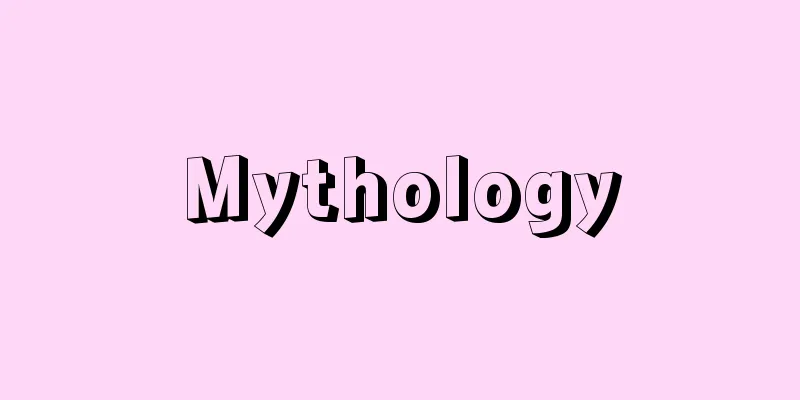Mythology

|
A discipline that studies mythology. Thanks mainly to the development of cultural anthropology, mythology has undergone a dramatic transformation since the mid-20th century. Until the first half of the 20th century, most experts believed that the emergence of mythology was impossible unless one reached a certain intellectual and cultural level. Furthermore, all myths were thought to be created with the purpose of explaining the origins of rituals, which were originally merely magical practices, by linking them to the activities of ancient gods, and rituals were considered to be the basis for their emergence. In other words, it was believed that the correct interpretation of a myth was nothing more than elucidating the connection to the rituals that created it. This misunderstanding arose from the prejudice that considered many of the nations on earth to be uncivilized and barbarian. The theories of anthropological authorities who had a dominant influence on the view of mythology at the time, such as Edward Burnett Tylor, James Frazer, Durkheim, and Lévi-Bruhl, were created by analyzing and collating superficial observational reports based on this prejudice at desks. These were nothing but fictions that were completely different from the facts about the people and cultures they despised, calling them "uncivilized" or "barbarians." Moving away from these early anthropological theories, new anthropologists began to conduct field surveys using academic methods, and the results of these surveys led to the recognition that myths are a universal cultural phenomenon for all human beings. This was the beginning of a new era in modern mythology research. The materials that are the subject of mythology research can be broadly divided into two types. On the one hand, there are myths that remain in documents, such as Greek mythology and Japanese mythology, and some of these, such as Egyptian and Mesopotamian mythology, have been discovered and deciphered through archaeological excavations. On the other hand, there are myths of non-literate peoples that have been passed down orally, and these are collected and studied by cultural anthropologists. In other words, the methods are very different, one is philology and the other is cultural anthropology, but in both cases, specialized knowledge of the culture that produced it is essential to study mythology. However, on the other hand, a sufficient understanding can never be obtained by studying only one mythological system, so the results of research by experts in other cultures must always be taken into consideration. In particular, among researchers of ancient mythology, there was a strong tendency until recently to consider it academic to study Greek mythology exclusively within the framework of ancient Greek culture, due to a backlash against the errors of past anthropological theories. However, in the myths of non-literate peoples, which are the subject of cultural anthropological research, there is still the possibility of observing how they are still being passed down and functioning in reality today. Therefore, research into ancient mythology must be conducted with the understanding that the essence of mythology can be elucidated through cultural anthropology. In fact, research into Greek mythology has come to be led by people who take cultural anthropological theory into consideration, such as JP Vernant (1914-2007) and M. Detienne (1935- ) of France, and GS Kirk (1921-2003) of England. They have made important contributions to mythology in general, and are counted among the most representative mythologists of our time. The two scholars who have made the most significant contributions to the innovation of modern mythology are G. Dumézil (1898-1986) and Lévi-Strauss. Dumézil, a French scholar of comparative mythology, restored the common structure of Indo-European mythology in great detail, reviving Indo-European comparative mythology, which had fallen into a state of complete stagnation. Strongly inspired and influenced by Dumézil's research, French cultural anthropologist Lévi-Strauss devised a novel method of structural analysis modeled on linguistics and applied it to the comparative analysis of Native American mythology. Lévi-Strauss's achievements, collected in a four-volume magnum opus bearing the common subtitle "De mythos," and Dumézil's extensive writings, are two of the great monuments of modern mythology. Furthermore, we should not overlook the contributions that Swiss depth psychologist Jung made to elucidating humanity's universal ability to produce myths through his "theory of archetypes." Even today, myths and pseudo-myths are believed by people without even realizing it, and are fulfilling the same functions in modern culture that myths have performed since ancient times. Jung's theory elucidates the function of myth, which continues to exist even in modern culture, which at first glance seems to have lost all mythology, and at the same time, it seems to provide a useful key to revealing why myths are essential to humans and their culture. [Atsuhiko Yoshida] "Introduction to Mythology" by Obayashi Taryo (1966, Chuko Shinsho) " "The Germanic Gods" by G. Dumézil, translated by Matsumura Kazuo (1980, Japan Britannica) " "Structural Anthropology" by C. Lévi-Strauss, translated by Arakawa Ikuo et al. (1972, Misuzu Shobo) Source: Shogakukan Encyclopedia Nipponica About Encyclopedia Nipponica Information | Legend |
|
神話を研究する学問。主として文化人類学の発達により、神話学は20世紀の中葉以後、今日までの短期間に面目を一新するほどの変貌(へんぼう)を遂げた。20世紀前半まで、大多数の専門家は、知能的、文化的にあるレベルに達しない限り、神話の発生そのものが無理だと考えていた。そしてすべての神話は、もとは呪術(じゅじゅつ)でしかなかった儀礼の由来を、太古の神々の活動と結び付けて説明する目的で生み出されるとして、儀礼こそがその発生の基盤とみなされていた。つまり神話の正しい解釈は、それを生み出した儀礼との結び付きを解明することにほかならないと考えられていた。 このような誤解は、地球上の多くの民族を未開な野蛮人とみなした偏見から生まれた。この偏見からの皮相な観察の報告を机上で分析し、また照合することによって生み出されたのが、エドワード・バーネット・タイラーやジェームズ・フレーザー、デュルケーム、レビ・ブリュールら、当時の神話観に支配的影響力をもった人類学の権威たちの学説である。それは、彼らが「未開人」とか「野蛮人」とよんでいやしめた人々とその文化の、事実とはまったく相違したフィクションでしかなかった。これら初期の人類学説から脱して、新しい人類学者たちにより、学問的方法で行われるようになった現地調査の結果から、神話は、人類にとって普遍的な文化事象であるという事実が認識された。そしてこの時点で、現代の神話研究の新しい歩みが始まったといえる。 神話研究の対象となる資料は、2種類に大別できる。一方は、たとえばギリシア神話や日本神話などのように文献に残されている神話であり、そのなかにはエジプトやメソポタミアの神話のように、考古学的発掘によって資料が発見され、解読されたものも含まれる。もう一方は、口伝えで伝承されている無文字民族の神話であり、その採集と研究は文化人類学者によってなされる。つまり、一方は文献学、他方は文化人類学と方法は大きく違うが、どちらの場合にも神話の研究のためには、それを生み出した文化についての専門的知識が不可欠である。しかしその反面で、一つの神話体系の研究だけからはけっして十分な理解は得られないので、別の文化の専門家による研究成果が絶えず参酌される必要がある。とくに古代神話研究家の間には、過去の人類学説の謬見(びゅうけん)に対する反発から、たとえばギリシア神話ならもっぱら古代ギリシア文化の枠内だけで研究することを学問的とみなすような傾向が、最近まで根強くみられたのである。 しかし、文化人類学的研究の対象となる無文字民族の神話には、現在でもなお現実に伝承され、また機能しているありさまを観察できる可能性も残されている。したがって古代神話の研究は、神話の本質が文化人類学によって解明されるという理解のもとに行われる必要がある。事実ギリシア神話の研究も、フランスのベルナンJ. P. Vernant(1914―2007)とデティエンヌM. Detienne(1935― )やイギリスのカークG. S. Kirk(1921―2003)など、文化人類学説に顧慮する人々によってリードされるようになってきた。彼らは、神話学一般にも重要な寄与を果たし、現代を代表する神話学者のなかに数えられる。 現代の神話学の革新にもっとも重大な貢献をした学者としては、デュメジルG. Dumézil(1898―1986)と、レビ・ストロースをあげなければならない。フランスの比較神話学者デュメジルは、インド・ヨーロッパ語族神話に共通する構造を、かなり細部にまでわたって復原させ、完全な沈滞状態に陥っていたインド・ヨーロッパ比較神話学を再生させた。フランスの文化人類学者レビ・ストロースは、デュメジルの研究から強い刺激と影響を受けながら、言語学をモデルにした斬新(ざんしん)な構造分析の方法を考案し、それをアメリカ原住民の神話の比較分析に適用した。『神話論』という共通の副題をつけられた4巻の大著に集成されたレビ・ストロースの業績は、デュメジルの膨大な著作とともに、現代神話学の二大金字塔である。 またスイスの深層心理学者ユングが、「原型の理論」によって、人類に普遍的な神話産出能力の解明に寄与したことも、軽視すべきではあるまい。現代でも神話あるいは擬似神話は、それと意識されずに人々に信じられ、古来神話が果たし続けてきたのと同じ機能を、現代の文化のなかで果たしつつある。ユングの理論は、神話など一見まったく喪失したようにみえる現代文化のなかでも、なお連綿と続いている神話の働きを解明すると同時に、人間とその文化に神話が不可欠である理由を明らかにするための有効な鍵(かぎ)を提供するように思われる。 [吉田敦彦] 『大林太良著『神話学入門』(1966・中公新書)』▽『G・デュメジル著、松村一男訳『ゲルマン人の神々』(1980・日本ブリタニカ)』▽『C・レヴィ・ストロース著、荒川幾男他訳『構造人類学』(1972・みすず書房)』 出典 小学館 日本大百科全書(ニッポニカ)日本大百科全書(ニッポニカ)について 情報 | 凡例 |
Recommend
Philoponos (English spelling)
He lived between the end of the 5th century and th...
Compound pier
…In Asia Minor and India, the capitals were often...
Pippin der Mittelere (English spelling)
…Father of Charles Martel. Also known as Pippin t...
Lactate dehydrogenase
An oxidoreductase that catalyzes the following rea...
convallarin
…In traditional Chinese medicine, the rhizomes of...
Training - Shugyo
As typified by the term "Buddhist training,&...
Meidner, L.
…Amid the conflict and exchange between the forme...
One character bit
...A cutting tool used to drill holes in rock. Fo...
Madara
…The churches are mostly basilica-style, such as ...
Mugi [town] - Mugi
A former town in Mugi County in the central-southe...
Tarenna
...An evergreen shrub of the Rubiaceae family tha...
Radar ranging - Radar sokkyo
Measuring distances using radar. A predetermined m...
Gilde
…Generally, it refers to trade associations of me...
Earl of Leicester
A favorite of Elizabeth I of England. Fifth son of...
Peel, Sir Robert
Born: 5 February 1788, Bury, Lancashire [Died] Jul...









